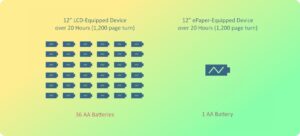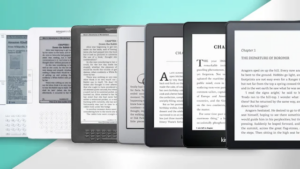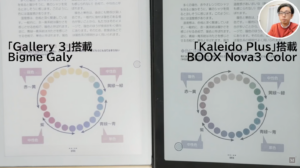E-Ink Technology: the Secret Behind Kindle
Introduction
Would you ever consider buying a new tablet if it was twice the price, half the reaction speed, and only a black-and-white display?
The 12.9-inch iPad Pro with the latest M2 chip starts at $1099, and the regular 10.9-inch iPad (10th generation) starts at just $449. In this case, why should any rational person spend $879.99 just to get an Onyx Boox 13.3-inch e-ink tablet Tab X with only a black and white display, a small 128GB ROM (read-only memory), no camera, and no fancy features?
E-ink is just like computers before they took off in the 1970s. While they are currently relatively expensive and underdeveloped, there is enormous potential for e-ink technology to become as ubiquitous as personal computers. In this essay, we will delve further into the principles behind e-ink, explore the advantages and disadvantages of such technology, and examine the commercial aspects of e-ink tablets and other e-ink devices. They are currently being used in a variety of products, and with further advancements in technology, it’s only a matter of time before e-ink devices are more widely adopted, providing users with even more versatile options in their digital lives.
E-Ink Device Categories
E-ink devices use electronic paper displays to mimic the appearance of ink on paper. There are several categories of e-ink devices available on the market, including e-readers, paper tablets, e-ink smartphones, and e-ink monitors.
Electronic paper tablets, or e-ink tablets, evolved from plain e-ink readers. With add-on features like note-taking, photo-taking, web browsing, etc., they can now offer versatile functions similar to those found on traditional LED tablets. In addition to e-ink readers and tablets, some companies, such as Hisense, are also developing e-ink smartphones. These devices use the same low-power e-ink technology as e-ink readers and tablets but in a smaller form factor. These phones typically have a black-and-white e-ink display and are designed to be used primarily for reading, although they have basic phone capabilities like making calls and sending text messages. Some other companies, including Dasung and Onyx Boox, are even working on e-ink monitors.
Principles Behind E-Ink and Electronic Paper Display
E-ink displays, or electronic ink displays, feature an ink system consisting of numerous micro-capsules filled with pigments that can float around inside the capsule and display different colors [1]. When varying the charge of electricity directed to the microcapsule, different pigments get attracted to the surface and therefore display different colors. There are various ink systems depending on how many different color pigments are present inside the capsules: a one-particle ink system using only black pigment; a two-particle ink system using black and white pigments; a three-particle ink system using black, white, and red pigments; and a four-particle ink system using yellow pigment as well. The latter two are able to display certain colors. Take the two-particle black-and-white ink system as an example (see [1, Fig. 1]). Each capsule is like a pond, and pigments are like fish in the pond. When all the black fish are attracted to the surface, the pond appears black, and this tiny area will appear black on screen. Consequently, it can reflect ambient light, producing the unique Electronic Paper Display (EPD), also known as an ePaper Display.

![]()
What distinguishes the EPD from the more popular liquid-crystal display (LCD)? LCDs are commonly used in digital watches, calculators, monitors, and televisions today. Backlights are typically mounted at the back of LCD screens to illuminate the display panel. Unlike LCD screens, early e-ink devices do not have any lighting systems and only work when an external light source exists. Starting in 2012, most e-ink devices have incorporated front light technology, an additional layer placed at the top of the screen that can disperse light evenly for comfortable reading experiences in various lighting conditions. See [2, Fig. 2] for a visual comparison of EDP, paper display, and LCD.

![]()
While various studies have indicated impaired reading performance with LCD compared to printed paper, Siegenthaler et al. [3] demonstrated in their study that there is no significant difference between the reading behavior with e-ink displays and with printed paper. This was achieved by comparing the reading processes regarding regressive saccades (a rapid movement of the eye between fixation points), background contrast, and reading speed. Surprisingly, the study found that using an e-reader actually enhances reading performance, given that participants exhibited shorter fixations. A longer fixation time usually indicates poor legibility as readers encounter difficulties understanding the materials. One possible hypothesis Siegenthaler et al. gave for improved legibility with e-readers is their ability to adjust the optimal font size for each user. In contrast, some people, especially the elderly, may have problems reading printed paper books with relatively small font sizes.
In another instance, Benedetto et al.’s study [4] draws a comparison of visual fatigue across LCD, EPD, and paper displays with long reading sessions (on average 73 mins). The results show that EPD and paper books have similar performance regarding visual fatigue, while LCD gives rise to higher eye fatigue compared to the former two, based on both subjective self-reported fatigue levels and objective fatigue levels estimated from eye blink frequency, a well-established indicator of eye fatigue.
Advantages and Disadvantages of E-Ink
One of the main advantages of e-ink technology is its ability to display text and images in a way that is easy on the eyes. The electronic ink used in these devices is reflective, meaning that it does not emit light on its own. Instead, it reflects ambient light, making the text and images appear more like those in a traditional paper book. Because of this, e-ink displays remain highly visible even in direct sunlight, while LCD screens tend to wash out in bright light conditions. Given all this, e-ink technology is especially beneficial for people who spend a lot of time reading or working on their devices, as it can reduce eye strain and fatigue.
Another advantage of e-ink technology is its low power consumption, as shown by [2, Fig. 3]. E-ink screens only require power when the image on the screen is changed, a technology referred to as “bistability” [2]. According to the E-Ink Corporation, 12-inch e-ink devices are 36 times more efficient than LCD devices of the same size. Also, a larger e-ink display is more efficient when compared to an LCD of the same size due to the “bistable” technology used in the former. This makes them ideal for use on the go or in areas with limited access to power.

![]()
E-ink displays are generally considered to have a higher resolution and sharper text display. This makes them perfect for reading books, magazines, and other written materials. The high resolution and sharp text display also make it perfect for note-taking and other tasks that require a clear and crisp text display. Moreover, it is also lightweight and portable, making it easy to carry around and travel with.
However, there are also several apparent disadvantages to e-ink products. First, they have limited colors. E-ink displays are primarily monochrome, displaying only black and white with varying shades of gray to create the illusion of depth. This can make it difficult to display certain types of content, such as vivid photographs or graphics that rely on color for their impact. While there have been some innovations in creating color e-ink displays, these are still relatively uncommon and may not be as vibrant or accurate as other display types.
Second, e-ink devices often cost more than traditional ones. The price of a 25-inch e-ink monitor is intimidating—more than $1,500 compared to a regular monitor, which is only around $200. This is due to the fact that E-Ink Corporation monopolizes e-ink display production, and nearly all products available on the market now, regardless of brand, are made with its e-ink displays.
Also, it is worth mentioning the delayed response time with the e-ink screen. For example, Kindle users often experience a delay in the display, which is still a common issue with almost all e-ink devices. Therefore, these devices are not yet ready for animations, videos, or any fast-changing displays but can be a good option for reading static materials such as books and articles.
History and Development of E-Ink Technology
By examining the evolution of the aforementioned Amazon Kindle e-reader, one of the most well-known products to use e-ink technology, we can gain insights into the development and advancement of this technology over the years. See [5, Fig. 4] for different Amazon Kindles, from oldest to newest.
The very first generation of the Kindle series was launched in November 2007. In the past fifteen years, more than 15 generations with various breakthroughs have been published. The first several generations did not have touch control and came with a huge keyboard under the screen for navigation. It was not until the Kindle Touch was published in 2011 that a touchscreen was implemented. In one year, the Kindle Paperwhite came with the very first front light installed, so that readers could read in the dark with brightness adjustment. More importantly, the sharpness of text has always been the most important focus and has been made possible only because of the development of e-ink technology. The original 6-inch display with 167 pixels per inch (PPI) advanced to 212 PPI in 2012 and 300 PPI in 2014. In the Kindle Scribe announced in September 2022, a 10.2-inch display with 300 PPI was used.

![]()
However, prices for the Kindle actually decreased over the years, even without considering inflation. The first generation costs $399. Now, the latest Kindle 11 is priced at $99.99 with ads and $119.99 without ads. This price drop is likely due to advances in e-ink technology and manufacturing efficiency.
Admittedly, even the latest e-ink readers, tablets, and monitors are still just accessory devices to full-colored, high refresh rate products because of their low performance in terms of color display, playing videos, and gaming. However, as we see in the case of Amazon, e-ink technology is evolving at an unprecedented speed. In fact, E Ink Corporation has been working constantly on pushing the boundaries of e-ink displays, especially full-color displays. As in [6, Fig. 5], the latest e-ink Gallery technology presents an advanced colored display used in Bigme Galy, the world’s first e-ink Gallery 3 tablet released in February 2023. As a result, it is reasonable to expect that e-ink technology will become increasingly competitive with LCDs in the future.

![]()
Conclusion
The trend towards creating faster, larger, and stronger devices is certainly an important one, as it allows for greater functionality and improved performance in many areas. However, it is equally important for new technology to consider user comfort and ease of use. This is where e-ink technology comes in, as it offers several advantages that make it a promising direction for the future. E-ink technology seeks a balance between functionality and comfort and has gained popularity as a result. As technology continues to evolve, we will likely see further innovations in e-ink technology that build on these advantages and make it an even more attractive option for a wide range of applications.
References
[1] “Electronic Ink: How it works.,” E Ink Technology. [Online]. Available: https://www.eink.com/tech/detail/How_it_works (accessed Jan. 27, 2023).
[2] “Benefits: ePaper displays bring a number of benefits to a product.,” E Ink Technology. [Online]. Available: https://www.eink.com/tech/detail/Benefits_4 (accessed Jan. 27, 2023).
[3] E. Siegenthaler, L. Schmid, M. Wyss, and P. Wurtz, “LCD vs. E-ink: An Analysis of the Reading Behavior,” Journal of Eye Movement Research, vol. 5, no. 3, Art. no. 3, Jul. 2012, doi: 10.16910/jemr.5.3.5.
[4] S. Benedetto, V. Drai-Zerbib, M. Pedrotti, G. Tissier, and T. Baccino, “E-Readers and Visual Fatigue,” PLoS One, vol. 8, no. 12, p. e83676, Dec. 2013, doi: 10.1371/journal.pone.0083676.
[5] “Amazon Kindle: A history of the world’s best e-reader,” Trusted Reviews, Apr. 13, 2016. https://www.trustedreviews.com/opinion/a-history-of-the-amazon-kindle-2946395 (accessed May 03, 2023).
[6] 進化したカラー電子ペーパー「Gallery 3」の鮮やかさがすごい!Bigme Galy 先行レビュー, (Dec. 24, 2022). Accessed: Jan. 27, 2023. [Online Video]. Available: https://www.youtube.com/watch?v=aRFW4R46-a0


